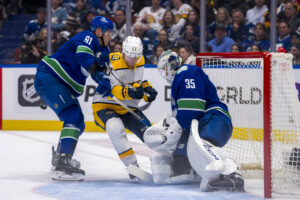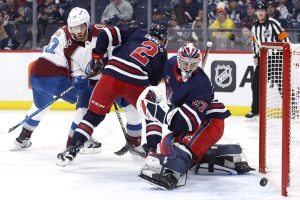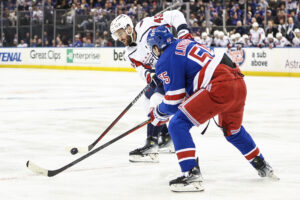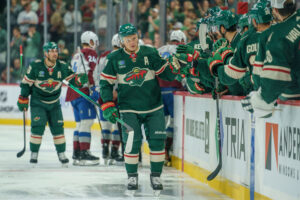After entering the league in 1970, the Vancouver Canucks draft history was entering its second decade in the 1980s. The team had started making the playoffs regularly, seven times throughout the decade. That wasn’t much to brag about, though, as only five of 21 teams in the league didn’t accomplish this feat. But any success was welcome to the young(ish) team and their fans. However, only twice would the Canucks break the .500 mark twice in their first twenty years.
Vancouver Canucks Draft History: The ’80s
Icons and Legends Arrive
This decade included their first run to the Stanley Cup Final in 1982. That’s sometimes enough, as the playoffs can be unpredictable for arguably the hardest trophy to win in sports. During that run came the iconic “surrender” of Coach Roger Neilson against the Chicago Blackhawks. How iconic? Ask the statue that stands outside of their arena showcasing the moment, commissioned decades later for the Canucks’ 40th anniversary.
Two legendary Canucks (and one legendary Boston Bruin) were drafted in the ’80s. Trevor Linden and Pavel Bure led Vancouver in the 1990s, the stars of what was a dominant Vancouver offence. Otherwise, the Canucks draft history here seemed to be more dependent on luck than skill. A dozen times, picks after the third round would supersede earlier selections, often by hundreds of games played. That those careers didn’t always come to fruition with Vancouver could be a sign of the Canucks giving up on a player too soon, undervaluing them, or just the cost of making trades.
1980
Canucks: (7th overall)
1st: Rick Lanz, D (569 GP, 286 P)
2nd: No pick
3rd: Andy Schliebener, D (84 GP, 13 P)
NHL Average
1st: F (518 GP, 406 Points); D (653 GP, 461 Points); G (N/A GP)
2nd: F (275 GP, 130 Points); D (468 GP, 127 Points); G (672 GP)
3rd: F (318 GP, 181 Points); D (335 GP, 67 Points); G (N/A GP)
1981
Canucks: (10th overall)
1st: Garth Butcher, D (897 GP, 206 P)
2nd: No pick
3rd: Jean-Marc Lanthier, F (105 GP, 32 P)
NHL Average
1st: F (670 GP, 575 Points); D (613 GP, 282 Points); G (868 GP)
2nd: F (184 GP, 70 Points); D (529 GP, 221 Points); G (3 GP)
3rd: F (112 GP, 42 Points); D (91 GP, 19 Points); G (447 GP)
1982
Canucks: (11th overall)
1st: Michel Petit, D (827 GP, 328 P)
2nd: No pick
3rd: Yves Lapointe, F(0 GP, 0 P)
NHL Average
1st: F (655 GP, 422 Points); D (837 GP, 356 Points); G (N/A GP)
2nd: F (356 GP, 203 Points); D (56 GP, 7 Points); G (N/A GP)
3rd: F (311 GP, 177 Points); D (50 GP, 21 Points); G (409 GP)
1983
Canucks: (9th overall)
1st: Cam Neely, F (726 GP, 694 P)
2nd: David Bruce, F (234 GP, 87 P)
3rd: Scott Tottle, F (0 GP, 0 P)
NHL Average
1st: F (723 GP, 537 Points); D (605 GP, 132 Points); G (777 GP)
2nd: F (320 GP, 177 Points); D (286 GP, 53 Points); G (N/A GP)
3rd: F (267 GP, 127 Points); D (211 GP, 39 Points); G (219 GP)
1984
Canucks: (10th overall)
1st: J.J. Daigneault, D (899 GP, 250 P)
2nd: Jeff Rohlicek, F (9 GP, 0 P)
3rd: David Saunders, F (56 GP, 20 P) Landis Chaulk, F (0 GP, 0 P) Mike Stevens, F (23 GP, 5 P)
NHL Average
1st: F (750 GP, 584 Points); D (654 GP, 279 Points); G (N/A GP)
2nd: F (455 GP, 239 Points); D (492 GP, 196 Points); G (180 GP)
3rd: F (186 GP, 137 Points); D (288 GP, 76 Points); G (515 GP)
1985
Canucks: (4th overall)
1st: Jim Sandlak, F (549 GP, 229 P)
2nd: Troy Gamble, G (72 GP)
3rd: Shayne Doyle, D (0 GP, 0 P)
NHL Average
1st: F (352 GP, 204 Points); D (749 GP, 260 Points); G (N/A GP)
2nd: F (349 GP, 220 Points); D (198 GP, 66 Points); G (428 GP)
3rd: F (96 GP, 52 Points); D (300 GP, 98 Points); G (146 GP)
1986
Canucks: (7th overall)
1st: Dan Woodley, F (5 GP, 2 P)
2nd: No pick
3rd: Don Gibson, D (14 GP, 3 P)
NHL Average
1st: F (445 GP, 286 Points); D (625 GP, 405 Points); G (N/A GP)
2nd: F (201 GP, 104 Points); D (269 GP, 86 Points); G (N/A GP)
3rd: F (139 GP, 37 Points); D (178 GP, 61 Points); G (43 GP)
1987
Canucks: (24th overall)
1 st: No pick
2nd: Rob Murphy, F (125 GP, 21 P)
3rd: Steve Veilleux, D (0 GP, 0 P)
NHL Average
1st: F (709 GP, 605 Points); D (642 GP, 163 Points); G (106 GP)
2nd: F (356 GP, 198 Points); D (246 GP, 81 Points); G (372 GP)
3rd: F (59 GP, Points); D (340 GP, 135 Points); G (0 GP)
1988
Canucks: (2nd overall)
1st: Trevor Linden, F (1382 GP, 867 P)
2nd: Leif Rohlin, D (96 GP, 32 P)
3rd: Dane Jackson, F (45 GP, 18 P)
NHL Average
1st: F (639 GP, 480 Points); D (291 GP, 51 Points); G (62 GP)
2nd: F (202 GP, 48 Points); D (66 GP, 20 Points); G (390 GP)
3rd: F (104 GP, 50 Points); D (0 GP, 0 Points); G (63 GP)
1989
Canucks: (8th overall)
1st: Jason Herter, D (1 GP, 0 P)
2nd: Rob Woodward, F (0 GP, 0 P)
3rd: No pick
NHL Average
1st: F (651 GP, 388 Points); D (263 GP, 51 Points); G (719 GP)
2nd: F (312 GP, 114 Points); D (430 GP, 111 Points); G (208 GP)
3rd: F (265 GP, 88 Points); D (457 GP, 291 Points); G (21 GP)
Vancouver Canucks Draft History: Predicting the Future
This decade probably has the clearest example of why collecting these stats is only really useful in retrospect: Nicklas Lidstrom.
While five defencemen were taken in total during the third round of the 1989 NHL Draft, three busted out. One did fine (Jason Woolley managed 718 games and over 300 points) and the last was, well, a legend. If your team took a D in that year, and that round, they probably missed: but you’d happily take those odds if the one-in-five shot was a first-ballot Hall-of-Fame member, wouldn’t you?
Likewise, it’s easy to say that picking Jean-Marc Lanthier in 1981 was a miss. Compared to the rest of the defence drafted around him, though, he was fine. They could have drafted Mike Vernon that round, but it’s safe to remember that he was the fourth goalie selected that year. That tells you how he was thought of by many scouts and teams. The reputation of the Canucks draft history among their fans is almost universally bad; but when the pickings are slim, what you end up with are slim pickings.
Blind Pigs and Acorns
There is always going to be some luck involved in drafting, however much money is spent on scouting departments. A team taking a chance on an unknown or under-scouted player is going to be increasingly rare as more information becomes available. But there’s always a chance someone was having a bad week when scouts were in town. Or they were from a remote corner of the world and are only known through statistics. Or were ignored because of a star player on their team.
Is something lost by that new accessibility? As good as Henrik Lundqvist is, the fight that the one New York Rangers scout to see him play had in getting the team to draft him at all makes for a great story as well.
Changing Too Soon?
The Canucks draft history has improved very recently, but by how much is yet to be determined. One reason the GM Jim Benning was hired was his strong scouting experience, showing which direction the owners wanted the team to move. While his very first pick played NHL hockey within two years, most of his selections have been allowed to age. As a result few of his picks have left statistical evidence for the strength of his drafting.
Whether it works or not is like everything else when drafting is involved: waiting for the future is the only way to tell.
Main Photo:






